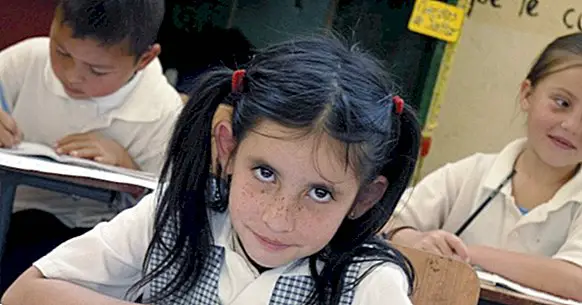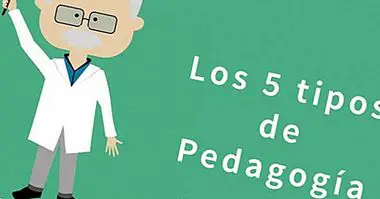The 5 fundamental pedagogical models
Educate and learn are common concepts, relatively easy to identify and we see reflected in our day to day often and in almost everything we do. However, understanding what it means to learn and what should be inculcated with both formal and informal education (especially in children and people in development), as well as how to carry it out, is more complex than it seems.
The different ways of seeing education have been generating that throughout history have been emerging and applying different pedagogical models . In this article we will observe some of the main models in this regard.
- Related article: "Educational psychology: definition, concepts and theories"
The main pedagogical models
There are numerous ways of conceptualizing learning, each having different repercussions depending on what practical effects that conception has. Many of the ideas regarding how it works or how the educational process should be carried out they have been developed and have been constituted as a more or less solid pedagogical model.
These models represent the set of relationships that explain a specific phenomenon, in this case learning. Having a pedagogical model allows us not only to have an explanation about it, but also to elaborate a series of guidelines that lead us to educate and strengthen certain aspects depending on the type of model chosen. There are a lot of pedagogical models, among which the ones we show below stand out.
1. Traditional model
The traditional pedagogical model, the most used throughout history, proposes that the role of education is to transmit a set of knowledge . In this relationship between student, educator and content the student is only a passive recipient, absorbing the contents that the educator pours on him. The protagonist role falls on the educator, who will be the active agent.
This type of model proposes a methodology based on the memory retention of the information, from the continuous repetition of tasks and without needing an adjustment that allows the granting of a meaning to the learned material.
Likewise, the level of achievement of the learning will be evaluated through the product of the educational process, qualifying the student according to the ability to replicate the transmitted information. The concept of discipline is given a high importance, being the teacher an authority figure , and knowledge is transmitted without critical spirit and accepting what is transmitted as true. It is based on imitation and ethical and moral development.
2. Behavioral model
The behavioral pedagogical model also considers that the role of education is the transmission of knowledge, seeing it as a way to generate the accumulation of learning. It is based on the behavioral paradigm in its operative aspect, proposing that any stimulus is followed by its response and the repetition of this is determined by the possible consequences of said response . At the educational level, the aim is to learn by modeling behavior, fixing information through reinforcement.
The role of the student under this paradigm is also passive, although it becomes the main focus of attention. The teacher continues to be above the student, in an active role in which he emits the situations and information that serve as a stimulus. The use of memory and imamitive-observational methodology abounds. The technical procedures and skills are usually well learned under this methodology at a procedural level, considering learning as behavioral change .
We work through a summative evaluation that takes into account the levels of expected behavior and the analysis of the products produced throughout the evaluation (such as exams).
- Maybe you're interested: "Behaviorism: history, concepts and main authors"
3. Romantic / naturalistic / experiential model
The romantic model is based on a humanist ideology that aims to take into account the learner as a protagonist and active part of learning and centralized in the inner world of the child. It is based on the premise of no directivity and maximum authenticity and freedom, assuming the existence of sufficient internal skills on the part of the learner to be functional in their life and looking for a natural and spontaneous learning methodology.
Under this model it is promoted that the development of minors must be natural, spontaneous and free, focusing learning on the free experience and interests of the child , being only the educator a possible help for this in case of need. The important thing is that the minor develops his internal faculties in a flexible manner. It is not theoretical but experiential: you learn by doing.
In this model, it is proposed that the subject it should not be evaluated, compared or classified , noting the importance of being able to learn freely without interference. At most, a qualitative evaluation is proposed, leaving aside the quantification to observe how the subject has developed.
- Maybe you're interested: "How is the Finnish education system, in 14 keys"
4. Cognitivist / developmentalist model
Based on the Piagetian conception of development, this model differs from previous ones in that its main objective is not to comply with the curriculum, but to contribute and train the subject in such a way that it acquires sufficient cognitive skills to be autonomous , independent and able to learn by itself. Education is experienced as a progressive process in which human cognitive structures are modified, modifications that can alter behavior indirectly.
The role of the teacher is to assess the level of cognitive development and guide students to acquire the ability to give meaning to what they learned. It is a facilitator in the stimulation of the apprentice's development, the bidirectional student teacher interaction being. It's about generating experiences and areas where you can develop , qualitatively evaluating the apprentice subject.
5. Educational-constructivist model
The constructivist educational model is one of the most widely used and accepted today. Based like the previous one on authors like Piaget but also together with the contributions of other outstanding authors such as Vigotsky, this model focuses on the student as the main protagonist of the educational process, being an essential active element in learning.
In this model, the teacher-student-content triad is seen as a set of elements that interact bi-directionally with each other. It is sought that the student can build in a progressive way a series of meanings , shared with the teacher and with the rest of society, based on the contents and orientation of the teacher.
A fundamental element for this perspective is that the learner can attribute meaning to the material learned and also to the learning process itself, with the teacher acting as a guide to learning and taking the latter into account the need to provide assistance tailored to the needs of the apprentice .
The aim is to optimize the capacities of the latter as much as possible, in such a way that it approaches the maximum potential level instead of being limited to its current actual level (that is, reaching the level at which it can reach with help). The control is progressively ceded to the student as the learning dominates, in such a way that a greater autonomy and capacity for self-management is achieved.
Bibliographic references:
- Castells, N. & Solé, I. (2011). Psychopedagogical evaluation strategies. In E. Martín and I. Solé (Coords). Educational orientation. Models and intervention strategies (Chapter 4). Barcelona: Graó.
- De Zubiría, J. (2006). The pedagogical models. Towards a dialoguing pedagogy. Bogotá, Teaching.
- Flórez Ochoa, R. (1999). Pedagogical evaluation and cognition. McGraw-Hill Interamericana S.A. Bogotá
- Vergara, G. and Cuentas, H. (2015). Current validity of pedagogical models in the educational context. Option, Year 31 (Special 6): 914-934.



















